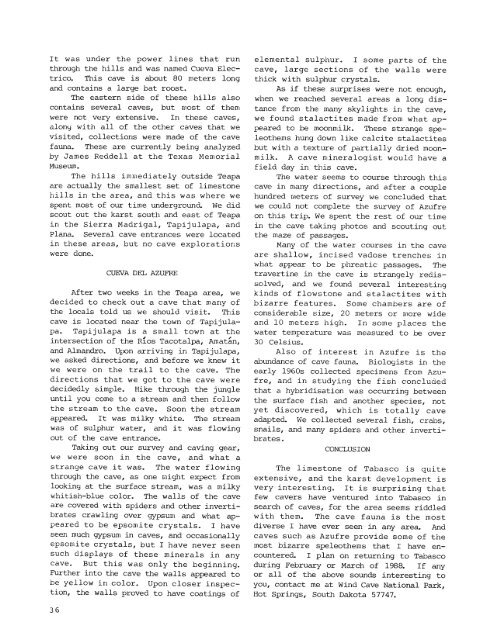8MB PDF - Association for Mexican Cave Studies
8MB PDF - Association for Mexican Cave Studies
8MB PDF - Association for Mexican Cave Studies
- No tags were found...
You also want an ePaper? Increase the reach of your titles
YUMPU automatically turns print PDFs into web optimized ePapers that Google loves.
It was under the power lines that runthrough the hills and was named Cueva Electrico.This cave is about 80 meters longand contains a large bat roost.The eastern side of these hills alsocontains several caves, but most of themwere not very extensive. In these caves,alony with all of the other caves that wevisited, collections were made of the cavefauna. These are currently being analyzedby James Reddell at the Texas MemorialMuseum.The hills immediately outside Teapaare actually the smallest set of limestonehills in the area, and this was where wespent most of our time underground. We didscout out the karst south and east of Teapain the Sierra Madrigal, Tapijulapa, andPlana. Several cave entrances were locatedin these areas, but no cave explorationswere done.CUEVA DEL AZUFREAfter two \\leeks in the Teapa area, wedecided to check out a cave that many ofthe locals told us we should visit. Thiscave is located near the town of Tapijulapa.Tapijulapa is a small town at theintersection of the Rios Tacotalpa, Arnatan,and Almandro. Upon arriving in Tapijulapa,we asked directions, and be<strong>for</strong>e we knew itwe were on the trail to the cave. Thedirections that we got to the cave weredecidedly simple. Hike through the jungleuntil you come to a stream and then followthe stream to the cave. Soon the streamappeared. It was milky white. The streamwas of sulphur water, and it was flowingout of the cave entrance.Taking out our survey and caving gear,we were soon in the cave, and what astrange cave it was. The water flowingthrough the cave, as one might expect fromlooking at the surface stream, was a milkywhitish-blue color. The walls of the caveare covered with spiders and other invertibratescrawling over gypsum and what appearedto be epsomite crystals. I haveseen much gypsum in caves, and occasionallyepsomite crystals, but I have never seensuch displays of these minerals in anycave. But this was only the beginning.Further into the cave the walls appeared tobe yellow in color. Upon closer inspection,the walls proved to have coatings ofelemental sulphur. I some parts of thecave, large sections of the walls werethick with sulphur crystals.As if these surprises were not enough,when we reached several areas a long distancefrom the many skylights in the cave,we found stalactites made from what appearedto be moonmilk. These strange speleothemshung down like calcite stalactitesbut with a texture of partially dried moonmilk.A cave mineralogist would have afield day in this cave.The water seems to course through thiscave in many directions, and after a couplehundred meters of survey we concluded thatwe could not complete the survey of Azufreon this trip. We spent the rest of our timein the cave taking photos and scouting outthe maze of passages.Many of the water courses in the caveare shallow, incised vadose trenches inwhat appear to be phreatic passages. Thetravertine in the cave is strangely redissolved,and we found several interestingkinds of flowstone and stalactites withbizarre features. Some chambers are ofconsiderable size, 20 meters or more wideand 10 meters high. In some places thewater temperature was measured to be over30 Celsius.Also of interest in Azufre is theabundance of cave fauna. Biologists in theearly 1960s collected specimens from Azufre,and in studying the fish concludedthat a hybridisation was occurring betweenthe surface fish and another species, notyet discovered, which is totally caveadapted. We collected several fish, crabs,snails, and many spiders and other invertibrates.CONCLUSIONThe limestone of Tabasco is quiteextensive, and the karst development isvery interesting. It is surprising thatfew cavers have ventured into Tabasco insearch of caves, <strong>for</strong> the area seems riddledwith them. The cave fauna is the mostdiverse I have ever seen in any area. Andcaves such as Azufre provide some of themost bizarre speleothems that I have encountered.I plan on returning to Tabascoduring February or March of 1988. If anyor all of the above sounds interesting toyou, contact me at Wind <strong>Cave</strong> National Park,Hot Springs, South Dakota 57747.36
















